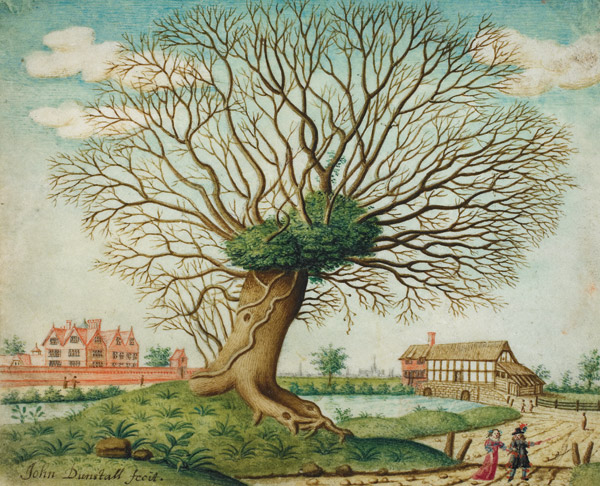The British Museum contains more about trees than one might expect: trees in paintings, drawings, sculpture, and all kinds of small artefacts of wood and bark. Frances Carey, sometime Deputy Keeper of Prints and Drawings, discusses trees as viewed through the collections. She deals not with trees themselves — for that one goes to the Natural History Museum and Kew Gardens — but with trees as interpreted (or misinterpreted) by botanical illustrators, divines, etchers, literary writers, medallists, metaphorists, mythologists, painters, poets, politicians and sculptors, on a worldwide scale going back to the Neolithic if not beyond.
Discussions of people’s varied reactions to trees are followed by an ‘Arboretum’: 24 chapters each dealing with one genus of tree. (Family trees and Trees of Knowledge appear separately.) Presumably these are chosen from those best represented in the museum’s collections. The final chapter is on the past and future of forests — but not trees outside forests which, as the pictures show, form most of the book’s subject-matter.
This book, being a product of the processes that established the museum’s collections, is a miscellany: a miscellany of fascinating thoughts, objects and illustrations. There are the birch rods borne by lictors, should the Ancient Roman plebs be in need of summary corporal punishment; all the different uses of paper mulberry; an astonishing medieval carved boxwood fiddle (what does it sound like?); the decapitated woodlands of the first world war (what became of them afterwards?); and leaves used to authenticate paper money.
Carey is a scholarly author, giving references for the reader to follow up her citations. Occasionally she is led astray by enthusiastic commentators, for example when she claims that Plato ‘described the deforestation of the hills around Athens to satisfy the navy’s demand for wood’ — Plato said nothing of the sort, and his words have been ‘improved on’ by successive generations of interpreters.
But she raises some interesting questions. Many pictures of trees are unconvincing, some indeed probably wrongly identified in the label. Portraying, and still more sculpting, a big tree is the most difficult task that an artist attempts. It can never be naturalistic, for life is not long enough, but has to be in the nature of a caricature. The artist tries to pick out the distinctive features that make it an individual oak or laurel, but few European artists succeed. Many of them hardly care about trees, which are just vague formulaic shapes to fill gaps in the composition. Why are Japanese and Chinese artists, who fill their blank spaces with clouds, so much better trained to convey the personality of trees?
A book on what people have said and thought about trees inevitably omits some aspects of their character. There are few portraits of individual trees (an especially English genre?). The chapters on cypress and poplar deal with the formal, rather un-tree-like gardeners’ varieties, and miss the majestic but little-known grandeur of the wild ones. The cedar chapter misses the fabled sacred cedars of Bsharri, one of the best recorded groups of trees in the world, which centuries of pilgrims thought were the only remaining cedars of Lebanon. Nevertheless, this is a book full of treasures, a delight to enjoy.






Comments